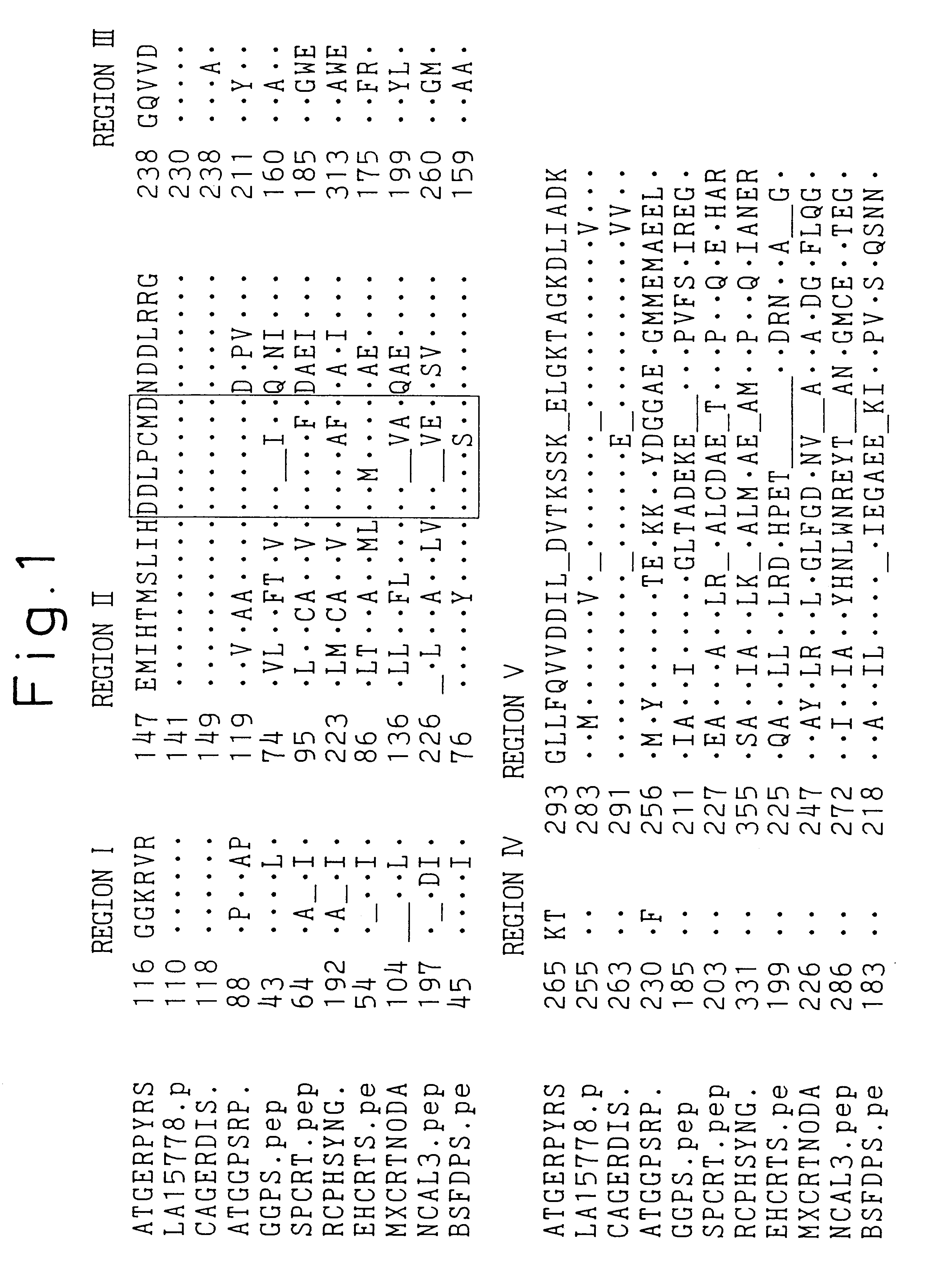Mutated prenyl diphosphate synthases
- Summary
- Abstract
- Description
- Claims
- Application Information
AI Technical Summary
Benefits of technology
Problems solved by technology
Method used
Image
Examples
example 1
Construction of a Plasmid Containing the Gene of Geranylgeranyl Diphosphate Synthase
The gene of the geranylgeranyl diphosphate synthase (hereinafter referred to as SacGGPS) derived from Sulfolobus acidocaldarius was subcloned at the HindIII site of the plasmid vector pBluescript II (KS+) commercially available from Toyobo Co. LTD. The plasmid DNA was designated as pBs-SacGGPS. The SacGGPS gene is available from Escherichia coli pGGPS1 / DH5.alpha. that was internationally deposited on Jan. 31, 1994, with the National Institute of Bioscience and Human Technology, Agency of Industrial Science and Technology, at Ibaraki, Japan under the accession number of FERM BP-4982.
Also, the entire nucleotide sequence of the SacGGPS gene has been published in Japanese patent application No. 6(1994)-315572, Shin-ichi Ohnuma et al. (1994), The Journal of Biological Chemistry Vol. 269:14792-14797, or a genetic information data bank such as GenBank under the accession number D28748. Since Sulfolobus acid...
example 2
Synthesis of the Oligonucleotides for Introducing Mutation
Introduction of mutation of the geranylgeranyl diphosphate synthase was performed by, firstly, introducing mutation by the methods as described in Example 3 using a plasmid that has integrated thereinto the mutant geranylgeranyl diphosphate synthase (F77S) gene in which Phe at position 77 has been substituted by Ser in the mutant SacGGPS obtained in accordance with Example 2 in the specification of Japanese Patent Application No. 7(1995)-247043. This mutant geranylgeranyl diphosphate synthase gene was constructed by a chemical mutagen treatment, but other methods such as Kunkel method or PCR method may be used to construct the gene.
For introducing the desired mutation, the following oligonucleotides were designed and synthesized.
Primer DNA 1 (L74G, F77S): 5' GGTGCAGCAATTGAAGTTGGTCATACT 3' (SEQ ID No: 5)
For introducing mutation by the method as described in Example 3 using the gene in which mutation has been introduced by prim...
example 3
The Introduction of Substitution-mutation of the SacGGPS Gene
Using each primer DNA constructed in Example 2, substitution-mutation was introduced into the plasmid in accordance with the Kunkel method in which the mutant SacGGPS gene had been introduced. A Mutan-K kit commercially available from Takara Shuzo was used to perform the Kunkel method. The experimental procedure was as described in the kit insert. The substitution-mutation of the plasmid need not be conducted by the Kunkel method. For example, an identical result can be obtained by a method using the polymerase chain reaction (PCR).
Using Escherichia coli CJ236 in the Mutan-K kit as the host cell, a single strand DNA was prepared in which a thymine base in the plasmid pBs-SacGGPS is replaced with a deoxyuracil base.
The single strand DNA thus obtained is used as the template in the reaction in which a primer DNA for synthesizing a complementary strand is treated in the following reaction solution at 65.degree. C. for 15 minu...
PUM
| Property | Measurement | Unit |
|---|---|---|
| Volume | aaaaa | aaaaa |
| Volume | aaaaa | aaaaa |
| Volume | aaaaa | aaaaa |
Abstract
Description
Claims
Application Information
 Login to View More
Login to View More - R&D
- Intellectual Property
- Life Sciences
- Materials
- Tech Scout
- Unparalleled Data Quality
- Higher Quality Content
- 60% Fewer Hallucinations
Browse by: Latest US Patents, China's latest patents, Technical Efficacy Thesaurus, Application Domain, Technology Topic, Popular Technical Reports.
© 2025 PatSnap. All rights reserved.Legal|Privacy policy|Modern Slavery Act Transparency Statement|Sitemap|About US| Contact US: help@patsnap.com

